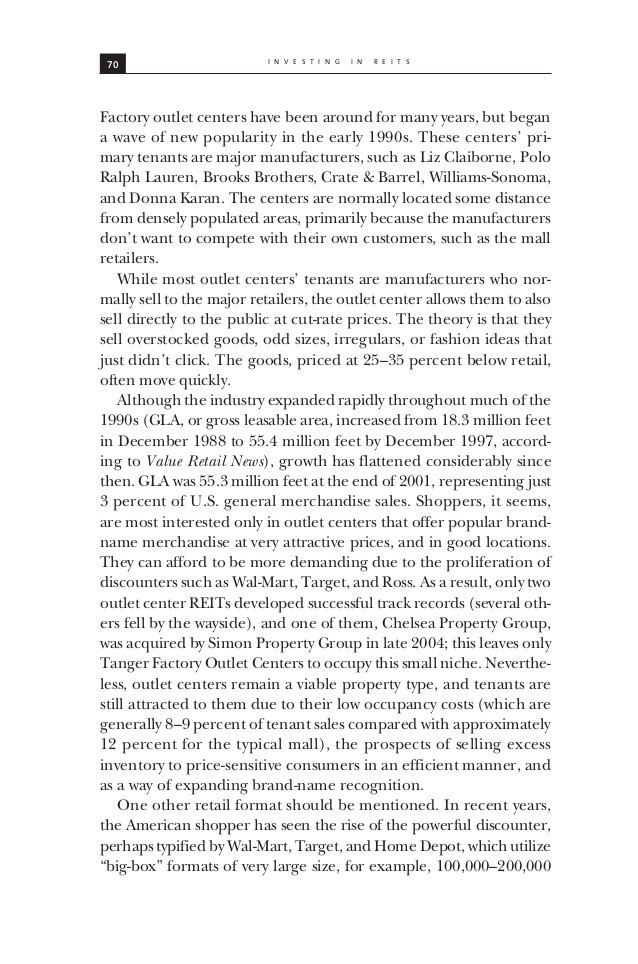UPREITs DownREITs And Other REIT Vehicles Should You Go Along For The Ride
Post on: 10 Август, 2015 No Comment

Table of Contents
Introduction
Since 1990, real estate investment trusts (REITs) have been the primary new vehicle through which investors have chosen to own real estate. Market capitalization has expanded from $5.5 billion in 1990 to nearly $140 billion as of June 30, 1998. With approximately 150 of the 300 REITs in existence now listed on the New York Stock Exchange and nearly 50 real estate mutual funds investing in REITs, the financial markets have become keenly interested in the REIT industry. REITs now represent 5% of the total market value of commercial real estate in the United States.
The strong trend towards real estate securitization and the tax-advantaged status of REIT vehicles has fostered new transaction and entity structures. UPREITs, Down-REITs, stapled and paper clipped REITs and their corporate analogs have become the real estate buzzwords of the Nineties. Understanding the business and tax considerations surrounding REITs, UPREITs, Down-REITs and their related structures is now an essential for a real estate owner or professional.
While originally created as a passive investment vehicle for real estate investors to obtain the same benefits that mutual funds provide for investors in securities, REITs are no longer passive vehicles. Prior to the Tax Reform Act of 1986 (1986 TRA), REITs were restricted as to the management services they could provide and were viewed as essentially fixed income investments. Accordingly, REITs were valued primarily by reference to their distributions. The 1986 TRA, for the first time, generally allowed REITs to directly provide services to tenants rather than to require an independent contractor to provide such services. As a result, REITs can presently provide a wide array of services without violating tax rules. Having taken advantage of the 1986 TRA changes, today REITs are valued in the investment world much like other active businesses.
The basic requirements for REIT status generally relate to the organization, income, and assets of the entity selected. In order to qualify as a REIT the entity must, among other things:

- be organized as a corporation, trust or association and be managed by one or more trustees or directors (856(a)(1)); 1
- have fully transferable shares or certificates of beneficial interest (856(a)(2));
- be owned by 100 or more shareholders (856(a)(5));
- not be a closely held corporation (856(a) and 542(a)(2); see also 856(h));
- derive at least 75% of its gross income from rents from real property, interest on loans secured by real property, gains from sale or other distribution of real property or real estate assets, abatements and refunds of real property taxes, and income and gain derived from foreclosure property (856(c)(3));
- derive no more than 30% of its gross income from the sale of real property held less than 4 years (excluding foreclosure property and involuntary sales) or securities held less than 12 months (856(c)(4));
- distribute at least 95% of its taxable income, excluding net capital gains (856(c)(2));
- invest at least 75% of the value of its total assets in real estate or real estate mortgages, cash and cash items, including receivables, and government securities (856(c)(5)(A));
- invest no more than 25% of the value of its total assets in securities, other than securities includible under the 75% test (856(c)(5)(B));
- invest no more than 5% of the value of its total assets in the securities of any one issuer, other than securities includible under the 75% test (856(c)(5)(B)); and
- own no more than 10% of the outstanding voting securities of any one issuer, other than securities includible under the 75% test (856(c)(5)(B)).
A REIT avoids double taxation through its status as a pass through entity. However, a REIT will be subject to tax to the extent of undistributed taxable income so it is typically viewed as being more akin to a taxable corporation that can reduce its tax through a dividends paid deduction.
The UPREIT structure was created to avoid recognition of taxable income on the transfer of appreciated property to a REIT. 2 UPREITs have accounted for nearly two?thirds of all newly formed REITs since 1992. Today, over half of the largest REITs are organized as UPREITs.
In a typical UPREIT structure, one or more individuals and/or partnerships owning real estate contribute their holdings to an umbrella partnership in exchange for limited partnership units, sometimes called operating partnership units. Contemporaneously, a REIT is formed and issues shares to the public. The REIT then contributes the proceeds received from the REIT shareholders to the umbrella partnership in exchange for a general partnership interest. The proceeds are used to reduce debt or acquire additional property or used for any other REIT purposes. The limited partners also receive rights to put their partnership interest to the umbrella partnership or to the REIT in exchange for cash or REIT shares. A diagram of a typical UPREIT structure is set forth in the figure below.














